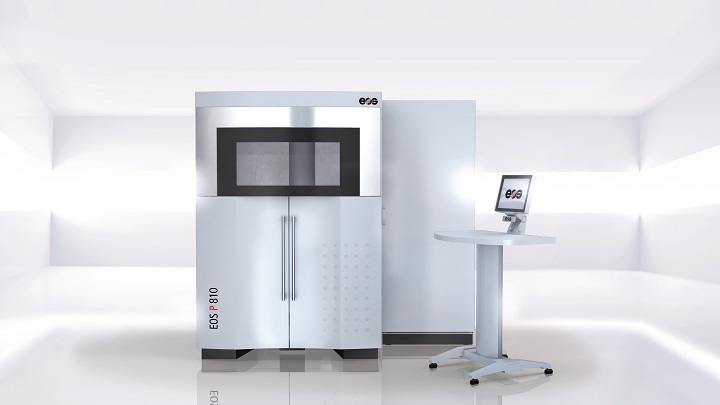![EOS P 810 [Image: EOS]](https://fabbaloo.com/wp-content/uploads/2020/05/EOS_System_EOS_P_810_frontview_HighRes28129_img_5eb0a941d4c69.jpg)
EOS is helping additive manufacturing move from the ‘wow’ to the ‘now’ with recent updates, Glynn Fletcher, President of EOS North America, tells us.
I spoke with Fletcher recently to catch up on the latest happenings at EOS, and he was kind enough to share his perspective on the year to date as well as a look ahead for the mainstay industrial 3D printing company. In 2018, he says, EOS is “enjoying a really successful year.”
The move from ‘wow’ to ‘now’ is the company’s key messaging as additive manufacturing is making the transition from rapid prototyping and the broad excitement about aspects of freedom of design capabilities into a larger focus on production.
“What is engaging a lot of people regarding additive manufacturing today is the potential impact it has on the supply chain, on distributed manufacturing,” Fletcher told me. “All of those things are beginning to have a lot more relevance.”
This relevance is seeing EOS appreciate a higher profile as additive manufacturing continues to move toward mainstream manufacturing. “All of the indications are that this will continue,” Fletcher noted, adding that North America is leading the way in this next wave of adoption.
“North America seems to be the market that is the most active at the moment, and enjoying the greatest growth spurt. This is certainly true for EOS,” he said.
With EOS’ portfolio encompassing advanced solutions for both polymeric and metal materials, I asked whether this growth was similar between the segments.
“The market is still a little bit weighted toward metals; metals seem to have more appeal at the production level. When we talk about metals, we can talk very ambitiously about the disruption of traditional techniques — metal cutting, metal removal techniques like milling and grinding, all those, and casting to some extent,” he said.
And polymers?
“We’re enjoying significant growth on the metals side, but I’m beginning to believe the polymers side will catch up pretty quickly,” he continued. “There are indications we are making good progress in the disruption of injection molding. Up until now, on the polymers side it has really been the domain of rapid prototyping. With some material advances, some flexibility and productivity advances in machines, we’re getting very excited about the potential in the polymer space.”
Advances in the transportation industry in particular are proving a driving force behind the growth for opportunities in polymer 3D printing. Aircraft interiors, spare parts for vehicles, made-to-order customized components for aerospace, and other applications in transportation are pushing innovation forward.
“We’re thinking that in this space, on the ground and in the air, there are some interesting projects being fulfilled ultimately with polymer solutions rather than traditional solutions or metal additive solutions,” Fletcher noted.
![Glynn Fletcher, President, EOS North America [Image: EOS]](https://fabbaloo.com/wp-content/uploads/2020/05/GlynnFletcher_img_5eb0a9424fd0a.jpg)
Parent company EOS GROUP is based in Germany, and Fletcher pointed out that trends are similar in Europe, though North America is presently “a little ahead…in terms of adoption for production.” This is leading to a more rapid increase in volumes, as this continent’s market is seeing sales for “machines in multiples now, in production applications.” These multi-machine sales are also being evidenced in Germany and in Asia, the latter of which Fletcher pointed to as an obvious target market for additive manufacturing.
“Asia is a fast-growing market as well; most machine tools in the world are installed in China. If additive is to make an impact in production, China must be a major market,” Fletcher said.
The supply chain advantages possible with 3D printing in production could lead to a potential disruption in traditional logistics — and with megafactories in China employing thousands of CNC machines under one roof, as Fletcher pointed out, manufacturing operations in the country will need to take notice. North American adoption of additive manufacturing has benefited from the potential to reshore production with the reshaping of the supply chain.
“One often-overlooked advantage of additive manufacturing is the ability to distribute manufacturing; you don’t have to have these CNC colonies in megafactories. That’s another reason maybe why there’s been a little more impetus in North America than in China, it disrupts the business model of businesses that in the last 20 years have thought about their supply chain in terms of where it would be lower-cost to produce. It had been a fairly easy decision to increase production in China, with megafactories, with lower labor costs,” Fletcher said. “Now consider inventory, warehousing costs, transportation costs, and the equation changes quite fundamentally.”
Rather, he pointed out, than look at central production and distribution, efficiency of production can be a higher priority. These considerations have been playing in to decision making, “and has led to some fairly fundamental changes in the way organizations, companies, and customers produce their products, and where they produce their products, and when they produce their products.”
We moved our conversation next from broader trends toward more specific product discussion: see part two of this interview.











